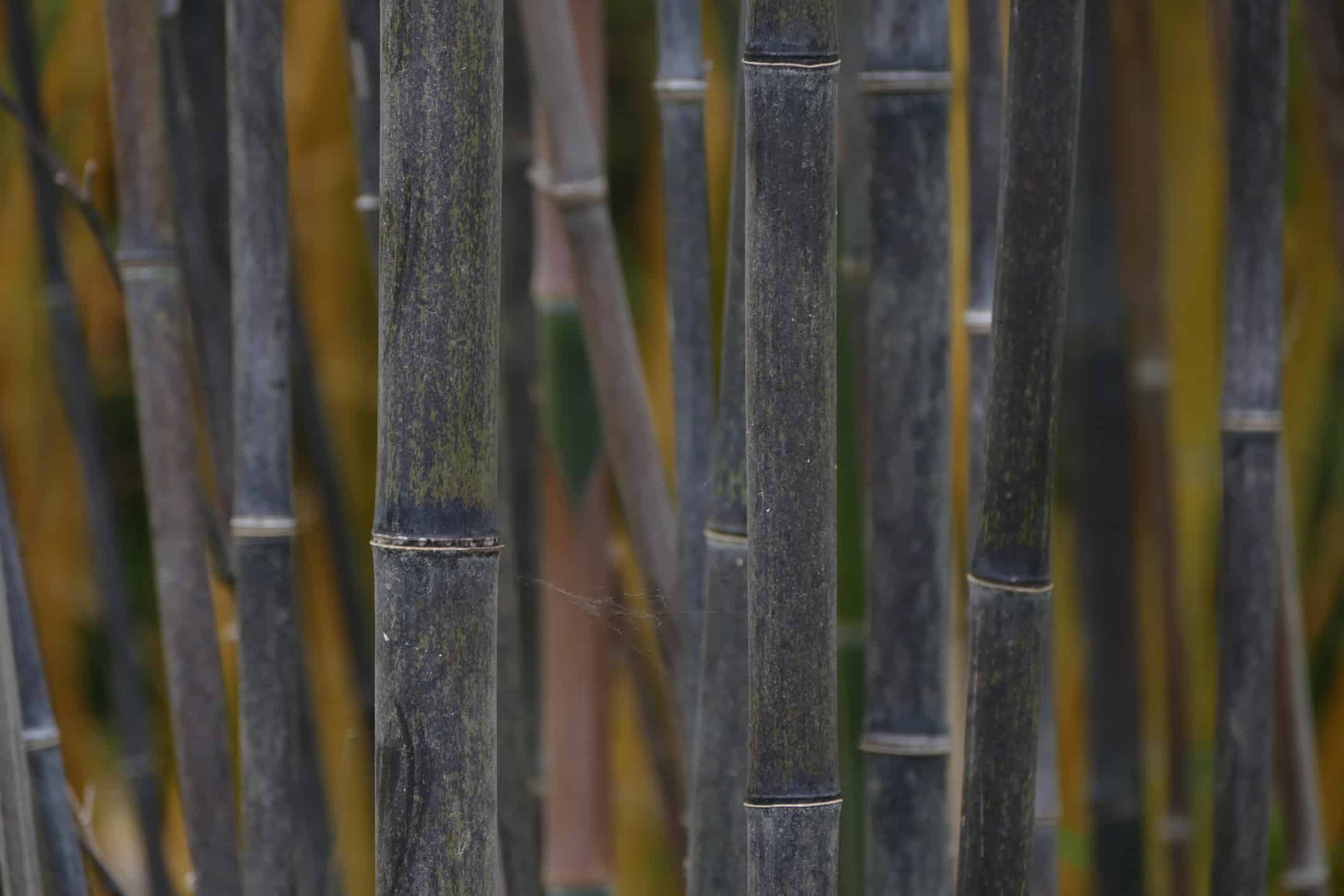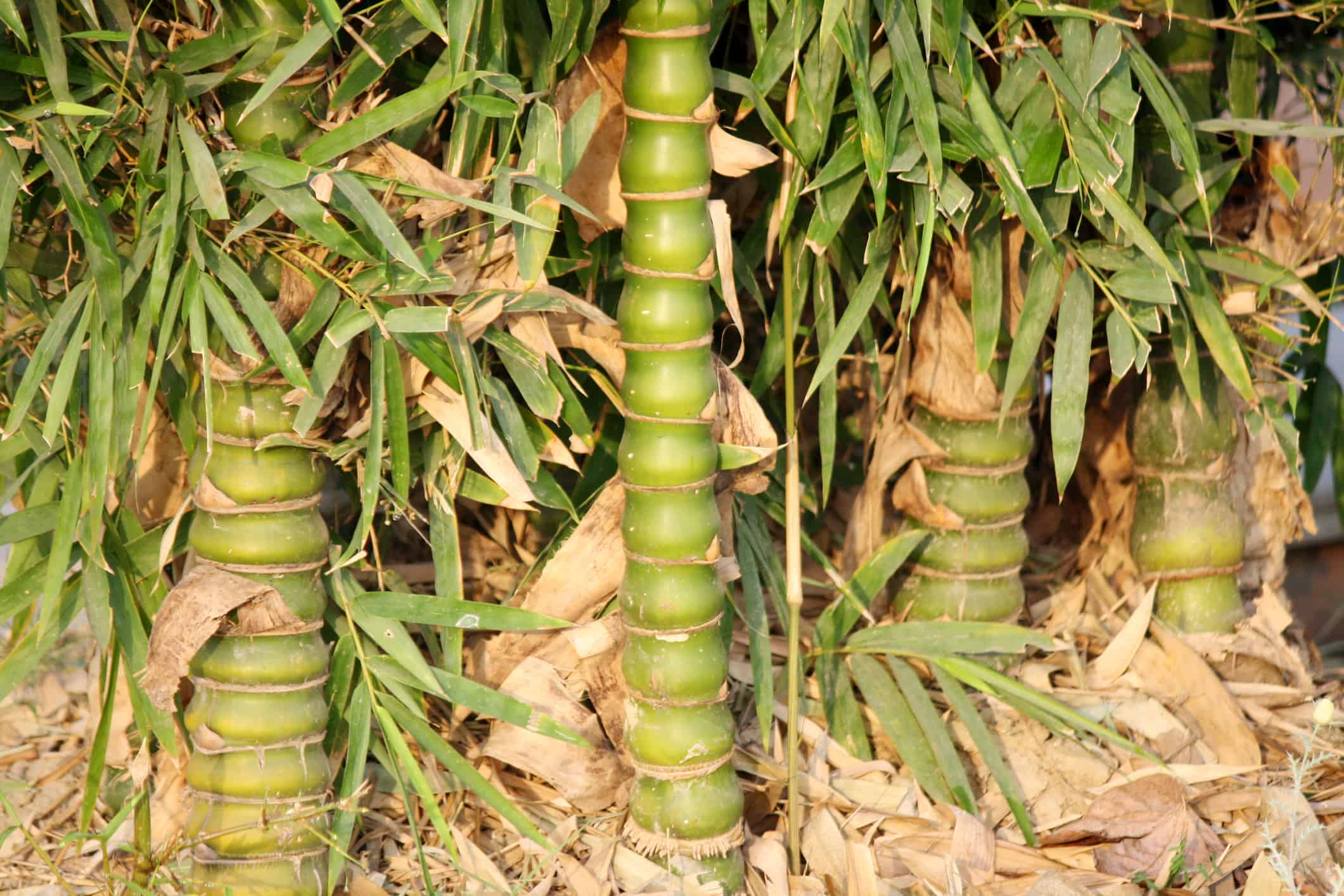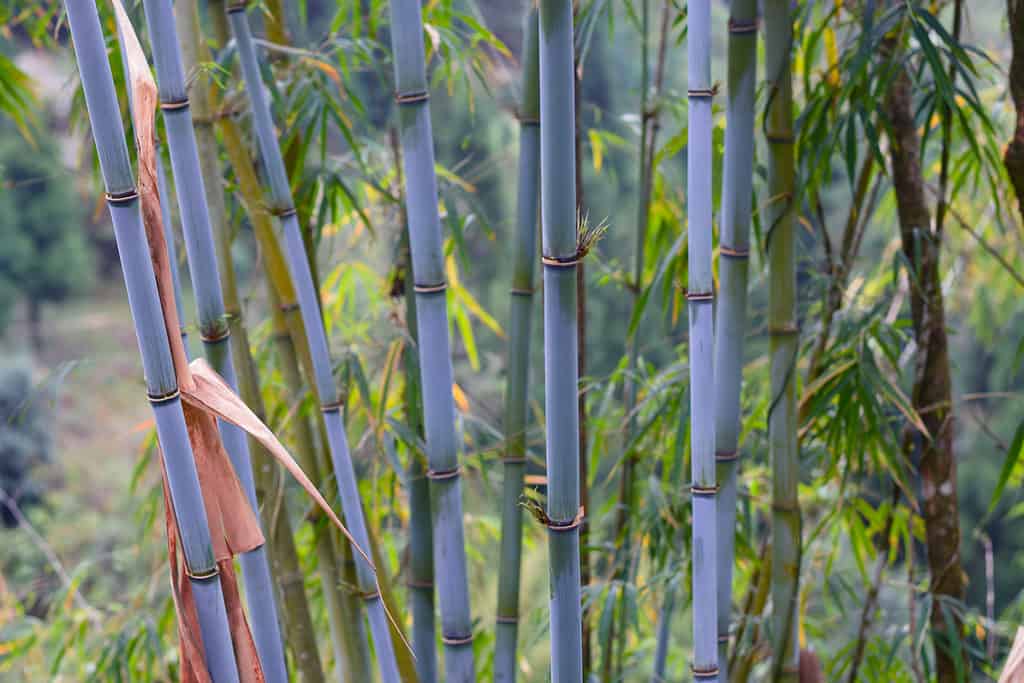Bamboos are incredibly diverse. These giant grasses are classified into about 100 genera which contain over 1400 distinct species. They exhibit numerous different colors and patterns, as well as varying culm heights and thicknesses. They are also hardy to a wide variety of conditions, from cold, montane habitats to hot and humid tropical forests. There are even herbaceous species of bamboo that are small and soft instead of hard and wood-like. It is usually easiest to group the many species into two main types based on their growth habits.
While there are some exceptions, the vast majority of bamboo species fit into two general groups. These are the running-type bamboos and the clumping-type bamboos. Below, we’ll talk about each of these types in more detail, explaining how and where they prefer to grow. We will also provide examples of genera, as well as some of their common uses in the landscape.
Running-Type Bamboo

The type known as running bamboo are temperate species and tolerate a much wider range of temperatures than the clumping type of bamboo.
©iStock.com/Jannick Tessier
The running type of bamboo is probably familiar to most gardeners and landscapers. Homeowners use them to create privacy walls, shade groves, and sound barriers. They are temperate species and tolerate a much wider range of temperatures than the clumping type of bamboo.
These plants produce “leptomorphic” rhizomes. This means that their rhizomes are long and expand rapidly, creating vast networks and sending up new culms in an unpredictable fashion. Although they have a reputation for being aggressive and uncontrollable, this reputation is often exaggerated.
Common Uses
Usually, people use running-type bamboo to fill open spaces in the landscape. Growers also use them to create elegant backdrops and tranquil shade groves. Due to the speed with which these species colonize, they make excellent privacy screens, windbreaks, and sound barriers.
Depending on the species, rhizomes can spread between 3 and 10 feet per year if conditions are right. Once the rhizomes have become established, they will begin sending up taller and taller culms. Each new culm will reach its maximum height in a single growing season, sometimes tens of feet tall!
The largest of running bamboo species, often referred to as timber bamboo, can grow to over 70 feet in height and produce culms that are over 4 inches in diameter. These bamboos are often grown for use in the construction of fences and buildings. They can also be processed down for use in a multitude of heavier duty crafting applications.
Notable Running Bamboo

Notable members of this genus,
Phyllostachys edulisand
Phyllostachys bambusoides, are considered timber bamboo.
©Legmiche, CC BY-SA 4.0 <https://creativecommons.org/licenses/by-sa/4.0>, via Wikimedia Commons – License
In addition to their growth rate, these bamboo species produce a wide variety of culm shapes, sizes, and colors. This makes them very aesthetically versatile. Species of Phyllostachys are commonly used for these purposes across the more temperate regions of the United States. They are easy to care for, have color variation, and poccess a tendency to grow in the 20–35-foot height range. Many species are hardy down to and below 0 degrees Fahrenheit. One particularly striking species, Phyllostachys nigra, produces green leaves and tall culms that turn deep purple or black with age.
Other notable members of this genus, Phyllostachys edulis and Phyllostachys bambusoides, are timber bamboo. Able to reach heights of around 75 feet, these are some of the largest varieties of running bamboo. And yes, once their shoots break ground, even these will reach their full height in a single season!
Chimonobambusa quadrangularis is a particularly interesting variety of running bamboo that is native to China. It is known as the square bamboo because it grows culms with square cross-sections. Its intriguing shape, in combination with its elegant, cascading foliage, makes the square bamboo a wonderful conversation piece. This species prefers cooler temperatures but, unlike many Phyllostachys, does not do well when water is scarce. It is also less tolerant of the cold. You should plant this species in areas where winter temperatures stay above 15 degrees Fahrenheit.
While many temperate bamboos species hail from Asia, there are a few North American natives as well. Arundinaria species, namely A. tecta, and A. gigantea, grow wild in the floodplains of the Appalachian region to as far north as New York. These runners produce very narrow culms that can reach 25 feet in the warmer southern growing zones. However, they typically reach 12-15 feet. The leaves of these species tend to grow in relatively tight, bushy groups around the culms. They may die off in particularly cold winters but will usually regrow in spring. The shorter Arundinaria appalachiana, known as the hill bamboo, grows in the same region but only reaches about 3 feet in height.
Containment Strategies
While they do spread quickly and their rhizomes can be difficult to monitor when they are not shooting, keeping these varieties of bamboo in check is not as difficult as it is portrayed. During the spring season, new shoots are soft and easily damaged. Simply kick or mow them over to prevent unwanted culm growth. The shoots of many species are edible as well once cooked. However, it is best to plan rhizome growth when planting your bamboo. There are a couple of common and effective methods of containment.
Trenching
The first method is more focused on monitoring and trimming back rhizomes. It involves digging a trench around the planting site. Because this type of bamboo produces rhizomes that grow so close to the surface, they will begin to emerge from the side walls of the trench as they approach the perimeter of the planting site. At this point, you can prune them back. The only real downside of this method is that it requires continual attention and labor throughout the plant’s growing seasons.
Installing a Rhizome Barrier
A second containment strategy takes the trenching method a step further and involves the installation of a physical rhizome barrier. Planters dig a trench, often at least 2 feet deep, around the planting site. They place the barrier inside and cover it with the fill dirt from the trench. Plastic barriers are most popular. You can purchase them in rolls that can wrap the entire perimeter of the planting site. Additionally, they only have a single seam. When installing the barrier, it is important that the top remains at least 6 inches above the soil to contain mulch and prevent more adventurous rhizomes from “climbing” over the barrier.
Clumping-Type Bamboo

Clumping bamboo grow slowly and are named for their general tendency to create compact clumps, like the Buddha belly bamboo.
©iStock.com/Sanjiv Shukla
Many gardeners are unfamiliar with the fact that there are entire genera of bamboo that behave significantly less aggressively. They grow more slowly and are named for their general tendency to create compact clumps. Many species of this bamboo type, in contrast to their running relatives, have a limit on their ability to expand.
The rhizomes of this bamboo group are described as “pachymorphic”, meaning thick. Rather than prioritize outward expansion, this type of rhizome spreads much less over the course of a single growing season. Running-type bamboos produce extensive, narrow lengths of rhizome that send up culms from a multitude of budding points. But these rhizomes prefer to turn themselves upwards to form new culms.
Common Uses
Because clumping bamboos tend to grow so slowly, it can take many years for their clumps to fill out. While some species are “open clumpers”, meaning that they have no upward limit to their clump diameter, many species stop expanding once they reach a certain size.
This makes clumping bamboo species ideal candidates for accent plantings, as well as use in containers and raised beds. Also, because it won’t fill out spaces quickly, this type is great for use as living trellises and as cover for shade-loving plants.
While their slow growth rate is often a positive attribute, it limits the practicality of their use as privacy screens and other barriers. Most North American growers eschew the planting of clumping bamboos because of their intolerance to cold. Because these types of bamboo hail primarily from tropical and subtropical regions, they are usually unable to survive cold temperatures.
Just like the running type, the clumping type also contains timber bamboos. They are sturdy, upright species that produce dense groups of thick-walled culms. They make building material that is unmatched by other bamboo in terms of size. These species can grow significantly taller than running bamboo and are able to attain heights of over 100 feet!
Notable Clumping Bamboo

Himalayan blue bamboo, a member of the genus
Himalayacalamus, is a montane variety of clumping bamboo that tolerates cold temperatures.
©PHOTOZON/Shutterstock.com
Though most clumping species of bamboo struggle in the cold, some are still able to tolerate it in short bursts. There are also a few notable cold-hardy exceptions to this rule. Members of the genus Fargesia are able to handle freezing temperatures down into the negatives. Some, like the fountain bamboo, Fargesia nitida, can survive in temperatures as low as -20 degrees Fahrenheit!
The South American genus of high-altitude clumping bamboo, Chusquea, also contains many cold-hardy species. Though not quite as cold hardy as Fargesia, they do well in areas where soil temperatures stay above zero degrees. These species also handle hot temperatures very well. Interestingly, Chusquea culms are solid all the way through, even at the internodes.
Himalayan blue bamboo, a member of the genus Himalayacalamus, is another montane variety of clumping bamboo that tolerates relatively cold temperatures. The low end of their temperature range is well above zero, sitting at between 15-20 degrees Fahrenheit. Unlike Chusquea bamboos, however, these species do not grow well in areas that experience hot temperatures and high humidity. While they are more limited in terms of growing range, these bamboo species can be particularly eye-catching. Many species of this genus present culms in an array of colors, ranging from light blue, to purple, to red. While this coloration fades with time, there will almost always be a mix of new culms among older ones.
Members of the clumping genus Dendrocalamus can grow to heights of over 150 feet! While they may not be practical for most planting applications, these species are surely awe-inducing. They are generally harvested for use in construction applications due to their straight, thick-walled structure.
Containment Strategies
Clumping bamboo species, owing to their slow rate of expansion, generally require no special containment strategies. In fact, planting clumping bamboo instead of a running type is often a containment strategy all its own. If a plant is expanding too close to the border of your garden or landscape, you can simply kick or mow over the new culm growth.
The photo featured at the top of this post is © PHOTOZON/Shutterstock.com
Thank you for reading! Have some feedback for us? Contact the AZ Animals editorial team.






